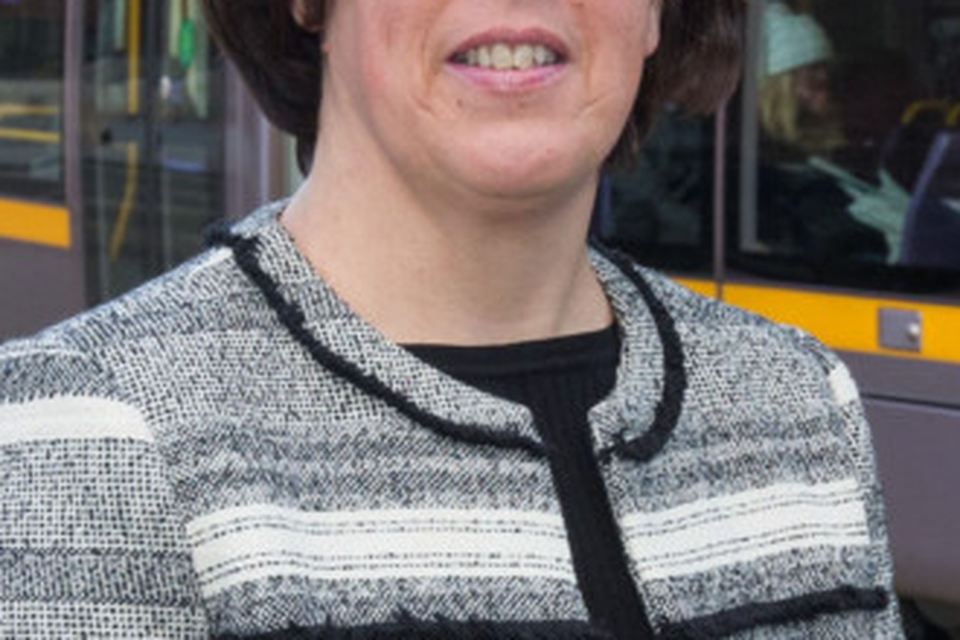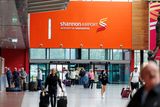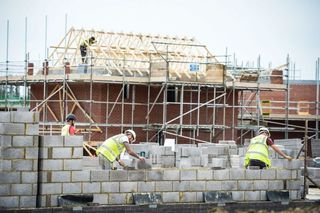A long, hard haul to keep Ireland Inc on the move
Dublin Airport's runway is full in the mornings, the M50 is fit to burst and public transport spending has been neglected for years. What are the people who run these networks doing about it? Sarah McCabe spoke to the people who oversee our roads, deliver public transport and run the country's biggest airports. She asked what they plan to do with the key Irish arteries that could be an economic heart attack in the making
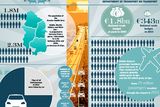

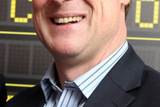
Michael Nolan - In his first ever interview, the Transport Infrastructure Ireland boss outlines his plans to address congestion: Michael Nolan understands the capacity issues facing the country's busiest road, the M50, very well. He passes over it every day, travelling by bus from his home in Mullingar to the headquarters of Transport Infrastructure for Ireland (TII) on Parkgate Street in Dublin.
TII came into being last August with the merger of the National Roads Authority and the Railway Procurement Agency. Nolan took over at the same time. His interview with the Sunday Independent is his first in this capacity. TII is responsible for building and maintaining the country's national roads network and overseeing the construction of light rail projects like Luas - it is in the middle of overseeing the Luas Cross City project which will connect its two existing Green and Red lines.
Nolan's budget is a fraction of what Ireland's road authority once enjoyed. In 2015 he had around €350m to maintain existing national roads and build new ones. At peak, around 2008, the national roads budget reached €1.8bn.
The Noughties were "an unprecedented time for road building in Ireland", he says. "At one point we had 560km of motorway under construction, more than anywhere else in Europe."
The end result was the Major Inter Urban routes, the motorways that connect Dublin with Waterford, Cork, Limerick and Galway. Work on these began in earnest early in the decade and the last contracts were signed around 2008, meaning these motorways were delivered even as the country's economy began to nosedive. The final piece was delivered in 2010 just as the IMF came to town. Unlike road building in the 1990s, which was heavily funded by Europe, Irish taxpayers paid for most of those routes.
That period of huge construction has left Nolan with a vast amount of road to maintain. Thus it is maintenance, rather than new road building, which seems to be his top priority. "We have 5,300km of national roads of which about 1,300km are motorways or dual carriageways. Most of that is new, built in the last 10 to 15 years. . . We have become an operator rather than a builder. Keeping that network open for businesses and citizens, and maintaining the value of taxpayers' investment - around €10bn - is our biggest concern."
To maintain the network properly - excluding any new building - costs around €300m a year. Given that his budget was €325m last year, Nolan estimates his organisation is underfunded by about €100m. "Government has acknowledged this and are doing their very best to address it," he says.
Despite being underfunded, new building is taking place and many other developments are at the planning stage. Five projects are in planning - two in Cork, one in Galway, one in Limerick and another in Donegal. Seven are preparing for construction; the top priorities among them are the widening of the M7 between Naas and Newbridge and work on the heavily congested Dunkettle Junction in Cork.
Three major schemes are actually under construction - the M17/M18 between Gort and Tuam, the M11 from Gorey to Enniscorthy, and the N25 New Ross Bypass. All are being funded via public-private partnerships (PPP), which cost less for the taxpayer upfront, but a change in government policy means future builds will be entirely paid for by the Exchequer.
The most congested city after Dublin is Galway, followed by Cork, Nolan says. "There are a lot of bottlenecks we need to free up at the moment."
The M50 is naturally one of his biggest headaches. Anyone who drives it early in the morning or between 5pm and 7pm will know that it is bursting at the seams during peak times. "The M50 has experienced unprecedented growth in the last few years," says Nolan, who has a background in civil engineering. The number of car journeys taken on the what was designed to be a strategic, radial route grew by 7pc in 2015, 5pc in 2014, 3pc in 2013 and 4pc in 2012. Average journey times have increased year on year. To drive the length of the M50 when it is quiet might take 35 minutes; that extends to about 75 minutes at peak, he explains.
The main problem facing the M50, Nolan says, is that too many people are using it for short journeys. "Last year it facilitated 350,000 car journeys every day, a lot of that hop on, hop off, non-strategic travel."
Adding more lanes is not an option, he says. "The M50 has finite capacity. We can't add fourth or fifth lanes, we don't have the land to do that. We did as much as we could do in terms of widening with the last piece of work in 2010."
TII has short-, medium- and long-term solutions to the M50's congestion problem. In the short term, it will revise the design of merging lanes. Two lanes currently allow drivers to merge on to the motorway at each junction and one of those is much shorter than the other, forcing the cars using it to merge into the slow lane very quickly. TII plans to extend that merging lane to give drivers more time, encouraging less braking.
In the medium term, the plan is to introduce variable speed limits via electronic signs dotted along the motorway. "This is a strategy used a lot on the continent and in the UK," says Nolan. Using the electronic signs, monitors could slow down traffic at busy times. At peak, they might drop the maximum speed allowed from 100km an hour to 60km an hour. "Slowing cars in times of high traffic reduces the frequency of incidents and prevents heavy braking coming to bottlenecks, which both improve journey times. Traffic is slower, but steadier," he says. Real-time management of traffic via electronic signs would also allow motorway managers to close the middle lane in the event of an accident, without closing the lanes on either side.
However, variable speed limits are only a medium-term solution; they will only give a degree of relief, he concedes. The long-term solution is demand management - meaning more tolls.
Multi-point tolling will be introduced, replacing the single toll currently in place around the Liffey Bridge part of the road. While plans aren't final, about five toll points are envisaged. "How else do you control access?" asks Nolan. "This is not a revenue-raising exercise. It is about addressing demand. The M50 currently costs about €100m to run - this includes the cost of paying off NTR, the windfarm company which owned the road until it was bought by the government in 2009, as well as the cost of motorway maintenance and running the tolling system. It is breaking even at the moment, solely from the revenue provided from the current single toll point.
The other long-term option is a second ring road around Dublin, but Nolan doesn't believe that is realistic. A route has been mapped "but there is no land available and it would be a huge investment," he says.
"At the end of the day you can't just keep building roads or widening the M50. It's got to be about public transport, an integrated public transport system." His organisation recently started working with the National Transport Authority on this, to make public transport planning one of the long-term solutions for the M50. Plans are not far advanced but at the centre of them is enhanced bus services on routes parallel to the M50, which may require building new or revamping existing roads.
In 20 years' time his wish is that Ireland's national primary and secondary roads are modernised, bottlenecks are removed and, crucially, major cities like Limerick and Cork are connected to each other by motorway, not just to Dublin, "with adequate funding to maintain it all".
Anne Graham - The head of the National Transport Authority, she is responsible for all public transport planning and delivery
The boom-time construction of an excellent motorway system highlighted by Michael Nolan is perhaps one of the reasons why car use has been on an upward trend in recent years, even during the recession. Total annual vehicle kilometres travelled increased by 1.2pc between 2011 and 2013, and three quarters of all journeys taken in 2013 used a car. There has also been a shift towards sole car use.
This means Anne Graham has a lot of work to do. "We believe policy priorities should now shift to public transport," she says.
Graham is head of the National Transport Authority (NTA), which was set up in 2009. Her organisation is responsible for public transport planning and delivery nationally. Its work includes doling out the taxpayer funds (the Public Service Obligation levy) which pay for Ireland's semi-state bus and rail companies and setting routes and service level expectations for those companies. It also licenses taxis and private buses, runs the Leap Card system and integrates different types of public transport so that users can move seamlessly from one to another.
Public transport usage fell in the wake of the recession, but recently returned to growth. Luas saw the biggest gains in passenger journeys in 2015 of any State-subsidised transport services, up 6.1pc; Irish Rail use was up 5.3pc, Dublin bus grew 2.8pc and Bus Eireann journeys were up 1.7pc.
This return to growth heralded price hikes. One of the NTA's more controversial roles is to set the price of public transport services. In 2015 it approved price rises across all types of public transport, bus, train and light rail. What is the justification for this if the NTA's aim is to increase public transport participation?
"The cost of operating public transport services is met by the fares revenue plus the subsidy that the government make available every year. The subsidy and fares were not sufficient to meet the operating cost for the services unless there was a small increase in fares even taking increased passenger numbers into account. In the case of Iarnrod Eireann services, the small increase still does not meet the deficit in funding the provision of the rail services" says Graham.
"We work very hard, when setting the rates, to strike a balance between fair fares for the customer and revenues required to maintain service levels for the travelling public. Some fares went down in the 2015 fares determinations, others went up. We are engaged in a multi-year process of simplifying the fares structures across all modes, so that they are easier to use and understand."
Funding is the NTA's biggest obstacle to the provision of public transport services, Graham says, followed by the difficulties associated with land acquisition for things like bus corridors, and planning permission obstacles. The NTA's budget was about €500m in 2015; this covered capital spending on new projects as well as the delivery of existing services.
Because it was originally conceived as a Dublin authority, the NTA has more responsibilities in the greater Dublin area, including Wicklow and Kildare, where it is responsible for strategic planning for all types of infrastructure including roads. Its latest set of plans for greater Dublin, a 20-year strategy running from 2016 to 2035, asks for a total of €10bn for a variety of new projects. Among them are the DART Expansion Programme (which will include DART Underground), a Metro North light rail line connecting Swords and Dublin Airport with the city centre, a rake of Luas extensions, new bus routes, a high-quality cycle network plan, pedestrianisation schemes and road upgrades. The implementation of its strategy, the NTA says, will decrease the percentage of people in greater Dublin driving to work from 62pc to 44pc and significantly increase the number of people living within one hour's journey time to the city centre by public transport.
Her priority is buses in Dublin. Dublin Bus is "the workhorse for the delivery of public transport in the region" she says, providing 120m passenger journeys a year.
The NTA has identified a number of corridors where buses need more priority, or new routes or extra vehicles should be added. Extra funding awarded by the Department of Transport this year for public transport, the first increase in the Public Service Obligation money available since 2008, is mainly going to buses in Dublin for fleet renewal.
Her second priority, she says, is the Luas Cross City project, work which is currently causing major disruption in Dublin city centre. Improving the integration of services and improved delivery of timetable information is her third - like the electronic signs popping up around the country which detail bus arrivals in real time.
Another NTA focus, Graham says, is the opening up of Public Service Obligation money to private companies. A tenth of the PSO must be made available to private bus companies by 2017. Private operators will be able to tender for the right to run services on routes of public interest, and receive a subsidy for doing so in the same way that Irish Rail and Bus Eireann do. Routes currently operated by Bus Eireann in Waterford and Kildare, and Dublin orbital routes operated by Dublin Bus, are already open. Arguably all of the PSO should be made available to private operators - but that would be damaging to those aforementioned semi-state companies. The National Bus and Railway Union threatened the NTA with a lawsuit on the matter, but it has been withdrawn.
"Please note that this is not 'privatising' routes; privatisation is about transfer of ownership and loss of public control" says Graham. "This is not the case here at all. The NTA is specifying details of bus services to be delivered - setting out fares, routes, frequencies, environmental standards, customer service standards - and is seeking submissions from the market on that basis. Any operator, including the current operators Dublin Bus and Bus Eireann, were eligible to participate from the outset. The successful tenderer will operate the specified services in return for an agreed fee, and will remit the collected fare revenues to the NTA. The NTA will maintain full control over service delivery and standards across all routes - in exactly the same manner as now applies to Dublin Bus and Bus Eireann."
Kevin Toland - The chief of the Dublin Airport Authority is in charge of the single busiest transport hub in the country
Foreign airlines interested in adding early morning routes to and from Ireland will struggle at Dublin Airport. The sole runway at the country's biggest air hub is already at full capacity between the hours of 6am and 7.30am; there's no more room at the inn. Airlines are being forced into taking later and later runway slots for early flights, with the result that many Irish travellers trying to make those flights are on the M50 just as it enters rush hour.
Other parts of the airport are filling up too. "We describe it like a factory with a number of different parts, you've got to break it down" says Kevin Toland. The former head of Glanbia's North American business took over the top job at Dublin Airport Authority (DAA) three years ago.
"You're full at different times in different places. We're full first thing in the morning at the peak hours on the runway. If you work back, Terminal 2 is pretty much full first thing in the morning in terms of based aircraft as well as keeping, with hotels, beds for people flying in overnight from America and the Middle East."
The cause is phenomenal growth in passenger numbers in the last two years, prompted by a marriage of economic recovery and a host of new routes. In 2015 the number of passengers passing through Dublin jumped by 15pc - three times more than the global average growth rate. The purchase of Aer Lingus by Willie Walsh's IAG - whose stated aim is to turn Dublin, Shannon and Cork airports into hubs for transatlantic travel - could push growth even higher next year. 11 new scheduled services have been announced for 2016 including flights to Hartford Connecticut, Los Angeles, Newark, and Vancouver, and charters to Cancun in Mexico and Montego Bay in Jamaica.
"We've had a number of years growth packed into the last two years" says Toland. "So, for example, Dublin grew last year at 15pc compared to airports globally which grew at 6pc and the EU which grew at 5pc.
"So we essentially had three years of growth last year. We now have very strong growth momentum in the business... We are quite literally growing in every direction.
"What we've been doing over the past number of years in response is gradually adding capacity, whether that's car park capacity - last year we added a number of floors to the multi-story carpark in Terminal 2; we've added additional security capacity each year in Terminal 1 and Terminal 2; we've a programme where we have been adding on more stands to be able to service more aircraft, coming on this year and again next year. DAA hired an extra 170 employees last year and 180 more will join this year.
"And the big one, obviously, is we are updating our plans on when we want to bring forward another runway."
The long-discussed second runway is now a question of when, not if. A fresh review of the project is underway with the aim of speeding everything up, to be concluded by the end of March.
"A runway is a long-term project so you've got to make sure demand is sustainable and is going to continue to grow" says Toland.
"We are in a very, very fortunate position in that we have the landbank; unlike a lot of airports across Europe that are looking at issues like this."
Getting the right planning permission, however, is a challenge.
"We have planning permission from 2007. There are some issues in that planning permission that doesn't meet our needs today, particularly as we develop Dublin as a hub and we develop the long-haul piece of our business.
Planning permission for the second runway as it currently stands constrains the number of flights that can be made between 11pm and 7am, and prevents the airport from using both runways at peak time between 6 and 7am. "It would be like if I added a new lane to the M50, but I wasn't allowed to use it when the road was busy."
The night-time flight limitation is particularly problematic for international flights, he says, and international passengers want to use Dublin as a gateway to travel elsewhere in Europe - the model being pushed by IAG in the wake of its purchase of Aer Lingus.
One million people used Dublin Airport as a transatlantic hub to travel on elsewhere last year and DAA wants to grow that to two million in the next two to three years.
"We have a great opportunity, particularly with the acquisition of Aer Lingus by IAG, to further build that business out both from the UK, where the IAG brand is very strong, and in North America, where you'd have to believe the sales power of the IAG machine will be strong."
"We need to make sure that when we build our runway, it's one that will serve our needs for the next 20 to 30 years."
It's not just long-haul that is driving growth, Toland points out. "How many UK cities or towns can you fly to from Heathrow? Eight. How many can you fly to from Dublin? Twenty-five. We are connected to 17 more." The easiest way for people from those 17 cities or towns to get to North America is to go through Dublin, he says, and into Europe too.
"What's really important about the runway is that it is not just about Dublin Airport, it is about the economy. What is far more important is facilitating growth in the economy, whether it's in tourism or foreign direct investment. It's no coincidence - look at the level of connectivity between Dublin and North America, look at the number of multinationals here, look at the fact that Dublin is the number six point of connectivity to North America.
"It's a critical national issue in terms of underpinning the economy. . . If we don't move we will see the airport, particularly around airside and the runway, getting busier and busier, which will lead to delays which we obviously don't want. The challenge we are trying to do is to figure how can we bring on a new runway as quickly as possible."
A second runway will cost in the region of €300m to build, Toland says. The aviation regulator has given approval to a hike in airport charges - about 60c per passenger on top of a fee base of €10 - which would cover some of this.
"On the other side, as we grow and add more passengers, that has the capability of reducing the fees. So we think that it's a win-win . . . growth in passenger numbers generally pushes aircraft charges lower. I think over time that will get reduced down."
The cost of adding an extra runway to Heathrow is €18bn to €20bn by comparison, he adds, while at Gatwick it would cost €4bn to €5bn. "We have the land and we have less infrastructure to put in than you would somewhere like Heathrow."
When he's not focused on building the airport's infrastructure, Toland is working on adding more routes. First on the list is a flight to China. "I'm working very hard to ensure that we can get a flight to China either announced or commenced by the end of this year. It is absolutely critical that this country is directly connected to one of the most important economic regions in the world... We are going to be marginalised if we are not." A direct route to Russia, Israel and Mexico City are also top of his wish-list.
Toland's responsibilities don't stop at Dublin. DAA runs Cork Airport too, as well as a commercial property development business, duty-free business Aer Rianta International and airport consulting start-up DAA International.
Cork's passenger numbers declined by 73,000 last year, about 3pc. Passenger numbers are down about 35pc since 2008.
"Cork had declined for a number of years, as have all of the airports outside of Dublin. Our focus last year was to get Cork stabilised and get it back into growth - which we achieved in the last quarter - and be in a position to get very strong growth."
Cork has been slow to catch up partly because of the country's improved roads infrastructure, he says. "Better motorways have meant more people will use Dublin . . . that's a fundamental change that isn't going away, bar the M50 gets clogged.
"Secondly, the recession has been far more pronounced outside of Dublin. We've seen that starting to change now, it was quite clear in the second half of last year. Thirdly, we have had to do quite a job not just in Cork Airport but in the region, pulling together stakeholders to support the airport, work on the right routes, the right marketing of Cork Airport and the broader south of Ireland. Two weeks ago you would have seen the launch of a new tourism brand for Cork city and county. There's been quite a job of work pulling together local stakeholders to support the airport and develop it.
Several new routes were announced for Cork airport last year and that is only the beginning, Toland says. "We're forecasting growth of 8 to 10pc in Cork this year, including our first transatlantic flight with Norwegian."
"It's the second most important economic, tourist and business centre in the country with a very large hinterland, a very large number of foreign multinationals, a natural gateway to the Wild Atlantic Way and so on.
"It has a lot of advantages."
Join the Irish Independent WhatsApp channel
Stay up to date with all the latest news

